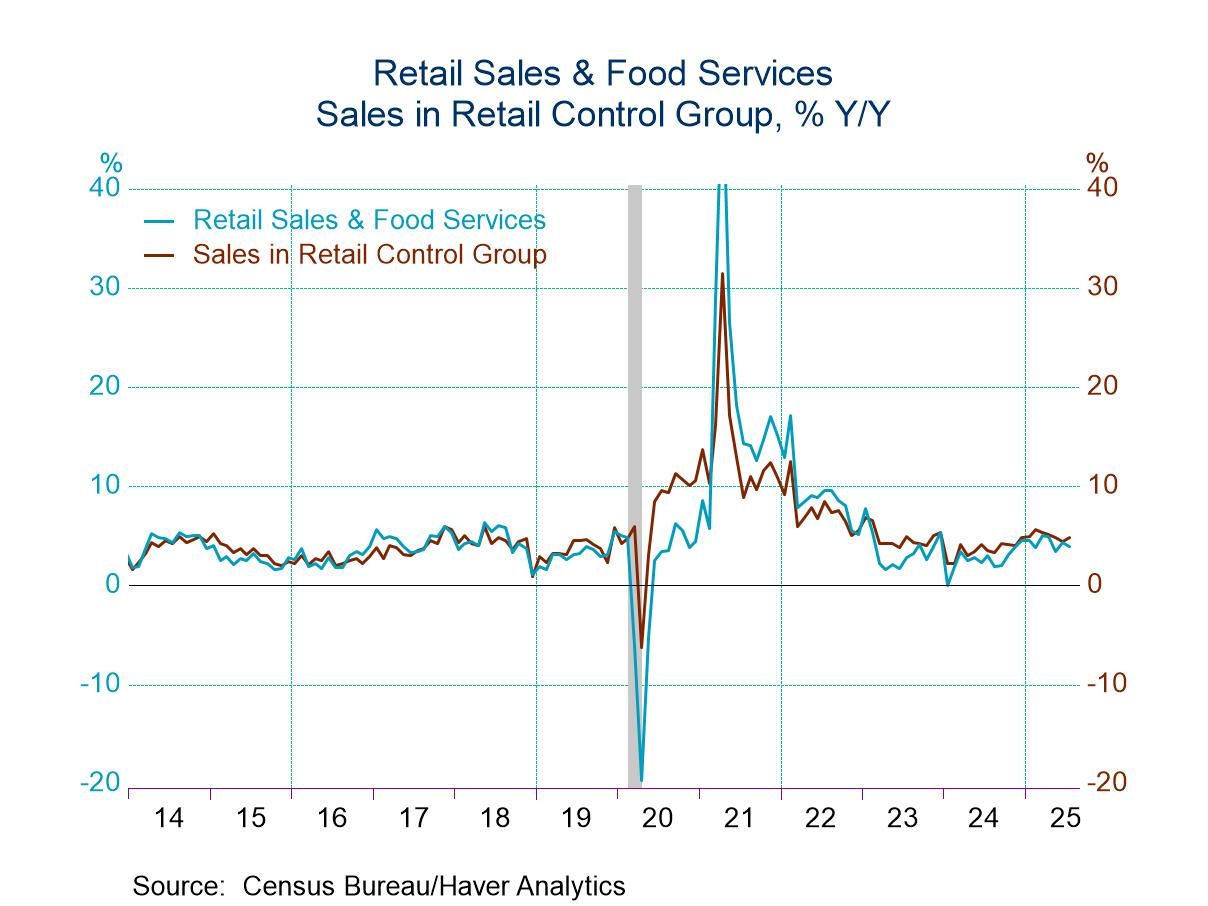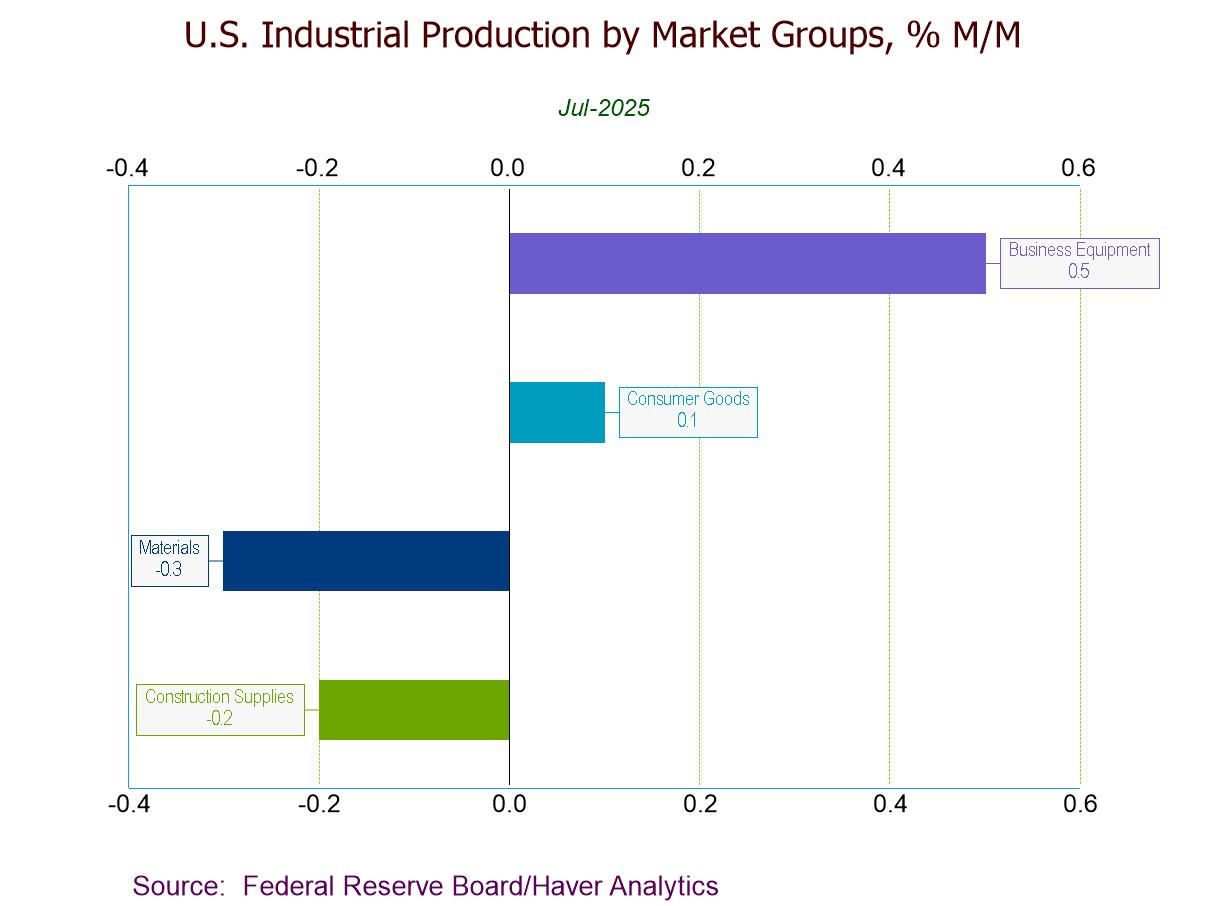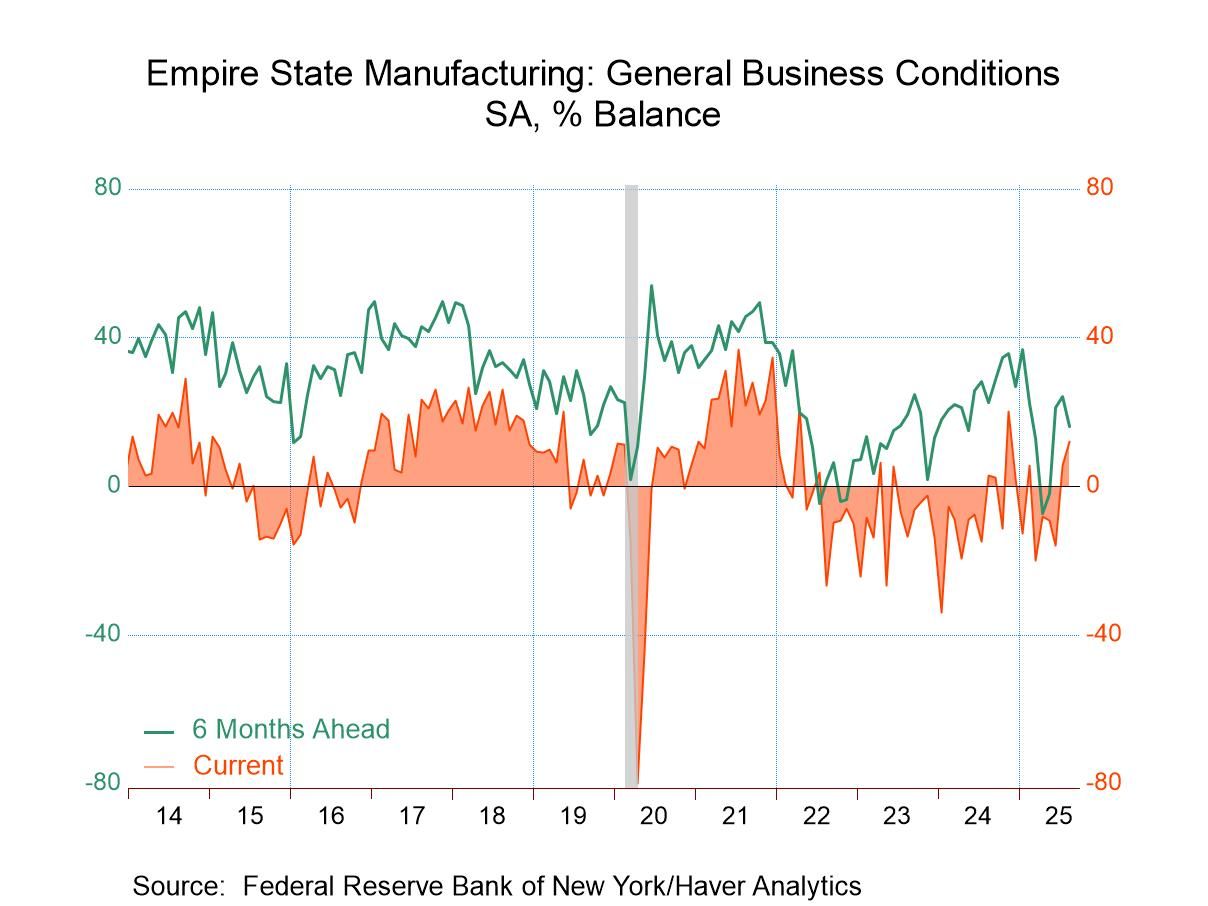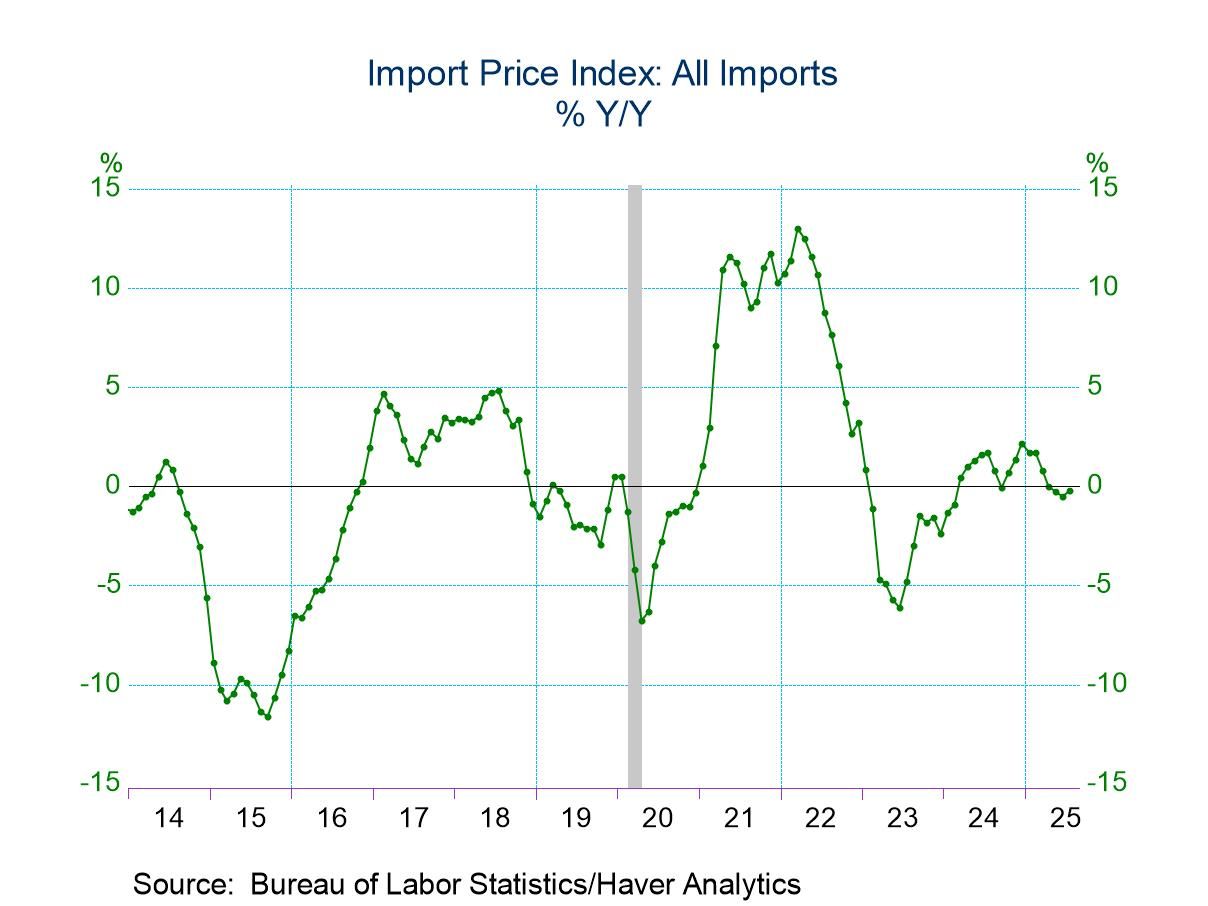 Global| Aug 20 2009
Global| Aug 20 2009Extended Benefits Dip
by:Tom Moeller
|in:Economy in Brief
Summary
The Labor Department indicated that initial claims for unemployment insurance increased unexpectedly for the second consecutive week to 576,000 after an upwardly revised rise to 561,000. The four-week moving average of claims, which [...]
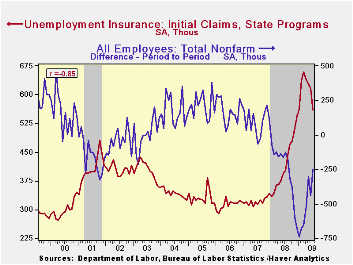
The Labor Department indicated that initial claims for unemployment insurance increased unexpectedly for the second consecutive week to 576,000 after an upwardly revised rise to 561,000. The four-week moving average of claims, which smoothes out some of the volatility in the weekly numbers, increased to 570,000 but was down from the April high of 658,750 and near its lowest level since late-January. A decline in weekly claims to 550,000 had been expected.
The latest figures cover the survey period for August nonfarm
payrolls and initial claims were up 17,000 (3.0%) from the July survey
period. During the last ten years there has been a negative 86%
correlation between the level of initial claims and the m/m change in
payrolls.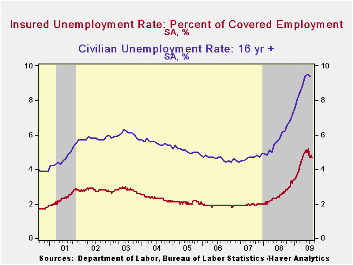
The Labor Department indicated that the largest increases in initial claims for the week ending August 8 were in Tennessee (+2,525), North Carolina (+2,469), Wisconsin (+2,078), Georgia (+1,753), and Washington (+1,697), while the largest decreases were in California (-5,635), Michigan (-1,490), Ohio (-951), Kentucky (-690), and Delaware (-226).
Continuing claims for unemployment insurance ticked higher in the latest week but remained down by nearly 10% from their late-June high, a decline which probably owes to the exhaustion of benefits. Continuing claims provide an indication of workers' ability to find employment and the level of 6,241,000 claims is up sharply from the year-ago level. The four-week average of continuing claims fell modestly to 6,266,000 and that was the lowest since late-April. The series dates back to 1966.
Extended benefits for unemployment insurance fell slightly w/w
at the end of July. The slip to 400,779 compared to a high of 491,684
reached during the middle of the month. Extended benefits began to rise
slowly in June of 2008 but surged by January.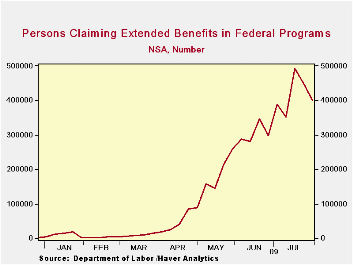
The insured rate of unemployment held steady at 4.7% which was the lowest level since mid-April. The rate reached a high of 5.2% during late-June. During the last ten years, there has been a 93% correlation between the level of the insured unemployment rate and the overall rate of unemployment published by the Bureau of Labor Statistics.
The highest insured unemployment rates in the week ending August 1 were in Puerto Rico (7.3 percent), Oregon (6.2), Pennsylvania (6.1), Michigan (5.9), Nevada (5.9), Wisconsin (5.5), California (5.3), Connecticut (5.3), New Jersey (5.3), North Carolina (5.1), and South Carolina (5.1). The lowest rates were in South Dakota (1.3) and North Dakota (1.5), Virginia (2.4), Wyoming (2.9), Texas (3.0), Maine (3.1), Colorado (3.2), Maryland (3.6), Minnesota (3.7), Florida (4.2), New York (4.2), Mississippi (4.3) and Georgia (4.7).
The unemployment insurance claims data is available in Haver's WEEKLY database and the state data is in the REGIONW database.
The Peak Oil Debate from the Federal Reserve Bank of Atlanta is available here.
| Unemployment Insurance (000s) | 08/14/09 | 08/07/09 | 07/31/09 | Y/Y | 2008 | 2007 | 2006 |
|---|---|---|---|---|---|---|---|
| Initial Claims | 576 | 561 | 554 | 31.5% | 420 | 321 | 313 |
| Continuing Claims | -- | 6,241 | 6,239 | 83.2% | 3,342 | 2,552 | 2,459 |
| Insured Unemployment Rate (%) | -- | 4.7 | 4.7 | 2.5 | 2.5 | 1.9 | 1.9 |
by Robert Brusca August 20, 2009
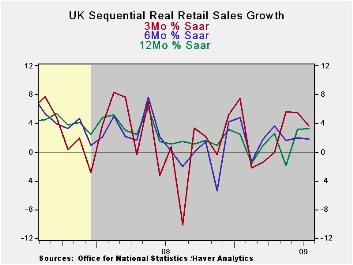
The 0.4% rise in real UK retail sales is the largest increase
in fourteen months. Retail sales ex autos also rose by 0.4% and put in
its second month-in-row increase.
The momentum in real retail sales is positive, having
recovered from some very deep lows reached just after mid-year in 2008.
In contrast this global business cycle hit the US consumer most
strongly at the end of 2008 and in early 2009.
UK food and beverage purchases have been a mainstay of growth
over the past year. But spending in this category fell in July.
Clothing and foot wear expenditures have run hot and cold and these
took a small decline in July as well. The strength in retail sales came
from other sectors in July.
In the quarter to date real ex-auto retail sales are growing at a robust 6.4% annual rate. The new quarter is only one month old but it is off to a very good start for UK retailers.
| UK Real and Nominal Retail Sales | ||||||||
|---|---|---|---|---|---|---|---|---|
| Nominal | Jul-09 | Jun-09 | May-09 | 3-MO | 6-MO | 12-MO | Yr AGo | Quarter-2-date |
| Retail Total | 0.5% | 0.7% | -0.5% | 2.9% | 2.9% | 2.6% | 3.1% | 5.1% |
| Food Bev & Tobacco | -0.4% | 0.7% | 0.5% | 3.0% | 7.1% | 5.2% | 7.1% | 1.2% |
| Clothing footwear | -0.1% | 3.2% | -2.2% | 3.3% | -1.4% | 2.7% | 1.0% | 7.8% |
| Real | ||||||||
| Retail Ex auto | 0.4% | 1.4% | -0.9% | 3.6% | 1.8% | 3.3% | 1.1% | 6.4% |
by Tom Moeller August 20, 2009
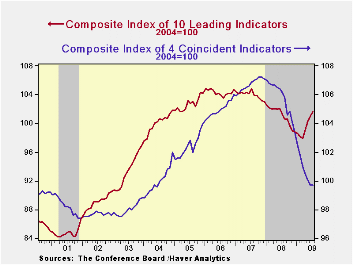
The Conference Board's Index of Leading Economic Indicators continued to suggest a pending economic recovery. The July composite index of leaders rose another 0.6% after gains of 0.8%, 1.2% and 1.1% during the prior three months. The combined 3.8% rise during those four months was the strongest since early-2002 while the index itself was at the highest level since last June. The leading index is based on actual reports for eight economic data series. The Conference Board initially estimates two series, orders for consumer goods and orders for capital goods.
For the fourth straight month, nearly three-quarters of the
ten components of the leading index increased.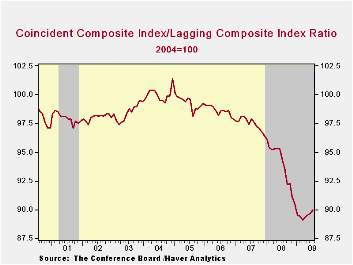
Again suggesting that the rate of decline in the economy is slowing were the coincident indicators which were unchanged m/m. This compares with monthly declines of 0.6%-to-1.1% dating back to September.
In a sign that excesses in the U.S. economy are diminishing, the lagging index fell for the seventh month in the last eight. The ratio of coincident-to-lagging indicators (a measure of economic excess) rose again m/m to the highest level since December.
The Conference Board figures are available in Haver's BCI database. Visit the Conference Board's site for coverage of leading indicator series from around the world.
| Business Cycle Indicators (%) | July | June | May | April 6-Month % (AR) | 2008 | 2007 | 2006 |
|---|---|---|---|---|---|---|---|
| Leading | 0.6 | 0.8 | 1.2 | 6.2 | -2.8 | -0.3 | 1.5 |
| Coincident | 0.0 | -0.4 | -0.4 | -5.4 | -0.9 | 1.6 | 2.5 |
| Lagging | -1.0 | -0.7 | -0.3 | -8.6 | 2.9 | 2.8 | 3.3 |
by Tom Moeller August 20, 2009
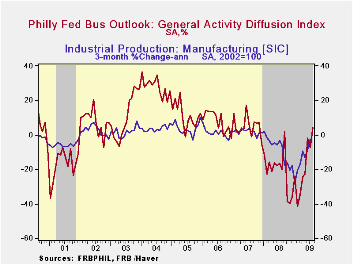
The Philadelphia Federal Reserve Bank indicated that its August index of factory sector activity in the region rose to its highest since November of 2007. The level of 4.2 compared to figures near -40.0 this past fall and winter. Consensus expectations had been for a slightly negative reading of -1.5 for this month.
During the last ten years there has been a 77% correlation
between the level of the Philadelphia Fed Business Conditions Index and
the three-month growth in factory sector industrial production. There
has been a 70% correlation with q/q growth in real GDP. The latest
survey from the Philadelphia Federal Reserve Bank can be found here.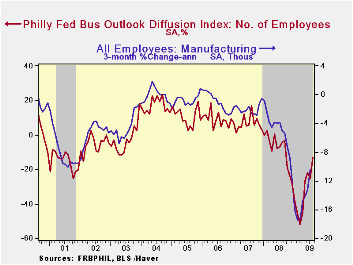
Amongst the components, new orders improved to 4.2 from -2.2 and the latest figure was the highest since 2007. A sharp rise in the inventory component to its highest since 2007 may indicate that the period of strong inventory decumulation reached its end. The latest figure of 0.3 compares to a low of -55.6 reached this past March. Also showing improvement was the employment index. It rose to a still negative -12.9 but that compared with a low of -52.0 during March. During the last ten years there has been a 79% correlation between the index level and the m/m change in manufacturing sector payrolls.
Improved pricing power accompanied the gains in real activity. The prices paid index jumped to its first positive reading since last October. During the last ten years there has been a 74% correlation between the prices paid index and the three-month growth in the intermediate goods PPI. There has been an 83% correlation with the change in core intermediate goods prices.
Expected business conditions in six months also have improved. The August index ticked up to 56.8 and recovered most of its July decline. The latest figure was still near its highest level since 2003. Most of the index components moved sideways at improved levels but the inventories series jumped sharply to new cycle high.
The figures from the Philadelphia Federal Reserve can be found in Haver's SURVEYS database.
| Philadelphia Fed (%) | August | July | August '08 | 2008 | 2007 | 2006 |
|---|---|---|---|---|---|---|
| General Activity Index | 4.2 | -7.5 | -20.1 | -21.3 | 5.0 | 8.0 |
| New Orders | 4.2 | -2.2 | -15.2 | -14.7 | 6.9 | 9.0 |
| Number of Employees | -12.9 | -25.3 | -4.6 | -8.7 | 6.8 | 9.0 |
| Prices Paid Index | 10.0 | -3.5 | 53.0 | 36.4 | 26.3 | 36.7 |
Tom Moeller
AuthorMore in Author Profile »Prior to joining Haver Analytics in 2000, Mr. Moeller worked as the Economist at Chancellor Capital Management from 1985 to 1999. There, he developed comprehensive economic forecasts and interpreted economic data for equity and fixed income portfolio managers. Also at Chancellor, Mr. Moeller worked as an equity analyst and was responsible for researching and rating companies in the economically sensitive automobile and housing industries for investment in Chancellor’s equity portfolio. Prior to joining Chancellor, Mr. Moeller was an Economist at Citibank from 1979 to 1984. He also analyzed pricing behavior in the metals industry for the Council on Wage and Price Stability in Washington, D.C. In 1999, Mr. Moeller received the award for most accurate forecast from the Forecasters' Club of New York. From 1990 to 1992 he was President of the New York Association for Business Economists. Mr. Moeller earned an M.B.A. in Finance from Fordham University, where he graduated in 1987. He holds a Bachelor of Arts in Economics from George Washington University.



